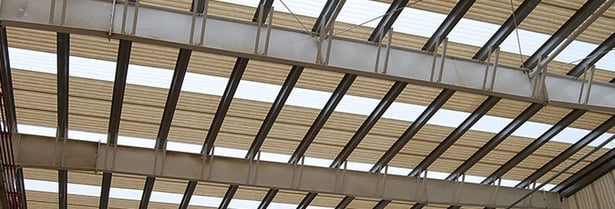Industries from wastewater treatment to aerospace to military to industrial construction all require specialized products that can withstand challenging conditions. Whether that's extreme weather or exposure to corrosive and harmful chemicals, traditional materials such as steel, wood, or even aluminum will not always stand up to the task.
That's where FRP products come into play, read this article to understand exactly what FRP is and how it can better suit your industry's needs.
What is FRP?
"FRP" is short for fiber-reinforced plastic or fiber-reinforced polymer, and is made up of glass fiber and resin. It's the resin and glass configuration that defines the particular benefit of a fiberglass product. Because the glass fibers can be arranged continuously, woven, or chopped, each configuration provides a unique strength reinforcement, density, and weight.
Additionally, it's the resin mixture that determines the specific characteristics that serve many industries. This includes the level of corrosion resistance, temperature/fire resistance, UV resistance, and can also be formulated to be conductive or halogen-free.
All of these features make FRP an attractive choice for industries such as:
- Agriculture
- Chemical and petrochemical
- Cooling tower
- Food processing
- Mass transit
- Metal processing
- Mining and minerals
- Oil and gas
- Pulp and paper
- Water and wastewater
As you can see, these industries are all very distinct, yet require solutions for challenging conditions. FRP performs well in these markets because of its chemical, temperature, and environmental resistance. Here's a quick look at the benefits of FRP and how it holds up against other building materials.
What are the benefits of FRP?
Thanks to their make-up, these fiberglass products offer many advantages over traditional building materials, like corrosion resistance, low weight, high strength, they are versatile and customizable, as well as have the ability to withstand extreme temperatures.
Fiberglass products are the most cost-effective material over a lifetime of various applications.
- They are extremely customizable and versatile, allowing you to use them in multiple applications that a traditional building material would not allow for.
- FRP products need little time for production and installation, without compromising durability or function.
- Highly impact resistant and won't break under impact as traditional materials might. You can get better performance with fewer materials.
- Save money and time on maintenance thanks to the strength, durability, and corrosion resistance. FRP products generally need less maintenance.
- Can better meet your structural needs due to the flexible nature of its design.
While many of the benefits of FRP may be dependent upon your industry's needs, some of the top reasons why companies choose FRP over other materials are its production and installation time, lightweight, and corrosion-resistant, and maintenance qualities.

So, how does FRP compare to traditional materials like wood or aluminum? Let’s find out...
Why choose FRP over traditional materials?
Traditional materials have higher maintenance costs, less flexibility, and are more susceptible to corrosion when exposed to extreme elements. While the advantages of FRP are quite obvious, it may be helpful to see the characteristics stacked up against those of other building materials.
- FRP vs Carbon Fiber: While carbon fiber's tensile strength is unmatched, it is much more rigid, costly, and not as durable as FRP. In addition, FRP is non-conductive and corrosion resistant
- FRP vs Aluminum: It goes without saying, but aluminum is very low strength and is vulnerable to impact, it's also highly conductive and can break or deform. When comparing FRP and aluminum, FRP will offer more reliable flex and strength needed for similar applications.
- FRP vs Steel: Steel is also highly conductive and susceptible to corrosion when exposed to the elements, making FRP a much better choice for challenging applications and impact.
- FRP vs Acrylic: While acrylic is the obvious choice for applications that are less likely to suffer dynamic stress, FRP is stronger and built to thrive in harsh conditions.
- FRP vs Wood: When weighing the benefits of these two materials, wood only wins in the category of upfront costs. However, while it is not a conductive material, it is nowhere near as strong as FRP, nor can it last in harsh environments or offer the safety features that fiberglass can.
FRP is built to thrive in challenging conditions and will do so consistently without a hefty cost. Not only does FRP offer longevity, but its dynamic nature also allows for some design capabilities. While other building materials may require paint or other coatings, FRP has a variety of resin options that can be customized to fit your specific needs.
If you're unsure that FRP is the right choice for your industry or you're concerned about switching materials, take a look through our case studies to get a better idea to see how our engineers can craft unique solutions.
Why choose Enduro's FRP systems?
As a world leader in industrial FRP/GRP systems, Enduro fiberglass products are installed around the globe in the United States, Latin America, Europe, Asia, and the Middle East. Through comprehensive programs of quality control and a world-class testing lab on-site at our headquarters, we can ensure consistent and effective product performance.
As one of the largest suppliers of fiberglass (FRP/GRP) products in the world, Enduro’s manufacturing capability is unmatched in diversity with the use of various manufacturing techniques. Our diverse manufacturing methods allow our team to offer cost-efficient and high-quality fiberglass products, such as pultrusion, continuous lamination, compression molding, resin transfer molding, open molding, spray-up, and fabrication.
Contact an Enduro Composites Rep Today
For additional information and assistance, please contact Enduro Composites, Inc. Our full list of product solutions plus informative case studies are included on our website. If the product needed is not shown, please consult our team for the custom product you need.
Sources:
https://www.sciencedirect.com/topics/engineering/fiber-reinforced-polymer
https://medium.com/@TreadwellComposites/why-choose-frp-grating-over-the-traditional-materials-available-9fc84535409e
https://bedfordreinforced.com/why-frp/how-frp-compares/